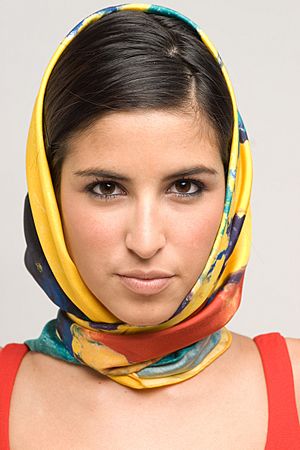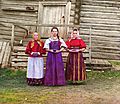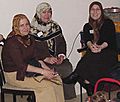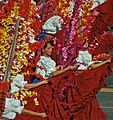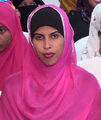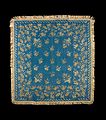Head scarf facts for kids
Headscarves are scarves covering most or all of the top of a woman's hair and her head. Headscarves may be worn for a variety of purposes, such as for warmth, for sanitation, for fashion or social distinction; with religious significance, to hide rampant baldness, out of modesty, or other forms of social convention.
Types of headscarves

Headscarves may have specific religious significance. Observant married Orthodox Jewish women, for example, are required to cover their hair, often employing scarves (or sometimes wigs) for the purpose. Headscarves were also worn by married Christian women in Medieval Europe, and even among some of the unmarried. This headcovering habit is better known as a wimple in English.
Islamic law says that women should dress in a special way. This dress code applies to women and adolescent girls, but not to children.
Headscarves and veils used for Muslim religious dress include:
Note that the Arabic word hijab refers to modest behaviour in general, and pertains to men and women, but it is sometimes used in other languages to describe the Muslim headscarf, also known as a khimar.
Some English speakers use the word "babushka" (grandma in Russian) to indicate the headscarf tied below the chin, as commonly worn in Eastern Europe. In most parts of Eastern Europe, headscarves are used mainly by elderly women (grandmothers) and this led the incorrect use of the "babushka" term. In Russia they are worn by women when they go to church to show their convictions to Russian Orthodoxy.
A plain red or scarlet headscarf was worn by female commissars and other women aligning themselves with Bolshevism in times of Russian Revolution and civil war.
A head tie is a west and southern African women's head scarf, specifically an elaborate ornamental head covering.
The Keffiyeh is commonly used by Muslim men.
Ancien Egyptiant men wore a Nemes headcloth.
Pictures of headscarfs
-
A scarf worn as part of a Norwegian national costume.
-
A Portuguese soccer fan wears a kerchief both as bandana and an expression of her club loyalty.
-
A woman wearing traditional headscarf in the 'babooska' style, in Kalkan, Turkey.
-
Women from Jaipur, India wearing Salwar kameez and dupatta.
-
A Mpondo woman from South Africa.
-
South African Dana Wien in a headscarf.
-
Gambian women in their traditional head ties.
-
Russian girls in their traditional head scarfs.
-
Bashkirian woman in traditional costume, photographed by Sergey Prokudin-Gorsky.
-
A cancer victim in a head scarf after losing her hair due to Chemotherapy.
Other pages
Images for kids
-
In Christian cultures, nuns cover their body and hair. Here an example of a 16th century wimple, worn by a widowed Queen Anna of Poland, with veil and a ruff around the neck.
-
Elizabeth II wearing a headscarf with Ronald Reagan, 1982.
-
Hutterite Anabaptist Christian women wearing headscarves.
-
A Christian woman in Russia wearing a shawl while reading the Bible.
-
A clerk working for Alitalia wears a headscarf in 1970
-
Distribution of Communion at a Tridentine Mass, women typically wear a headcovering.
-
A headscarf for chefs; Los Angeles, 2007
-
A Chinese man with headscarf in his fashion costume.


